【备课参考】(人教)高中英语必修5同步教学课件:Unit+5+First+aid+Workbook(共53张PPT)
文档属性
| 名称 | 【备课参考】(人教)高中英语必修5同步教学课件:Unit+5+First+aid+Workbook(共53张PPT) | 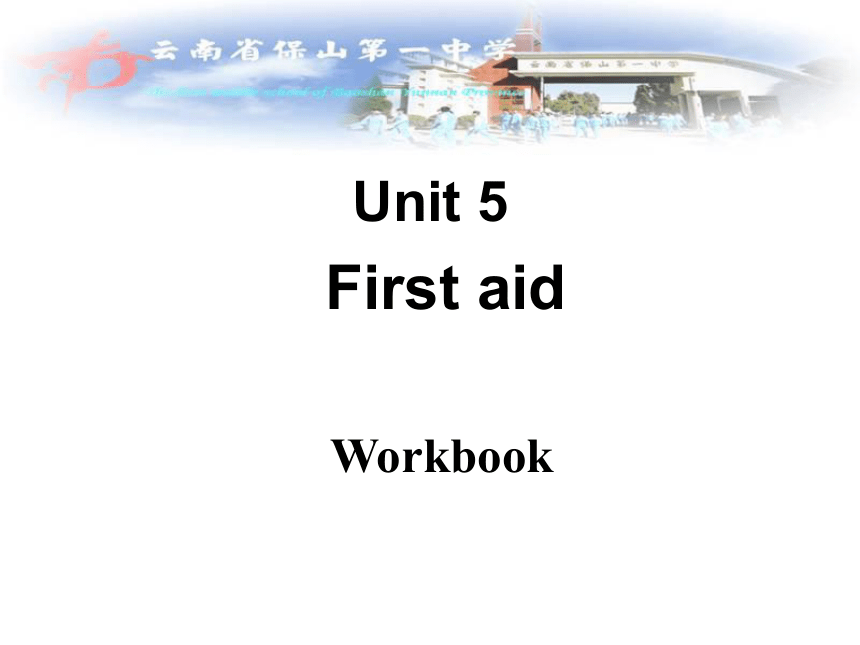 | |
| 格式 | zip | ||
| 文件大小 | 4.1MB | ||
| 资源类型 | 教案 | ||
| 版本资源 | 人教版(新课程标准) | ||
| 科目 | 英语 | ||
| 更新时间 | 2015-07-29 18:31:13 | ||
图片预览

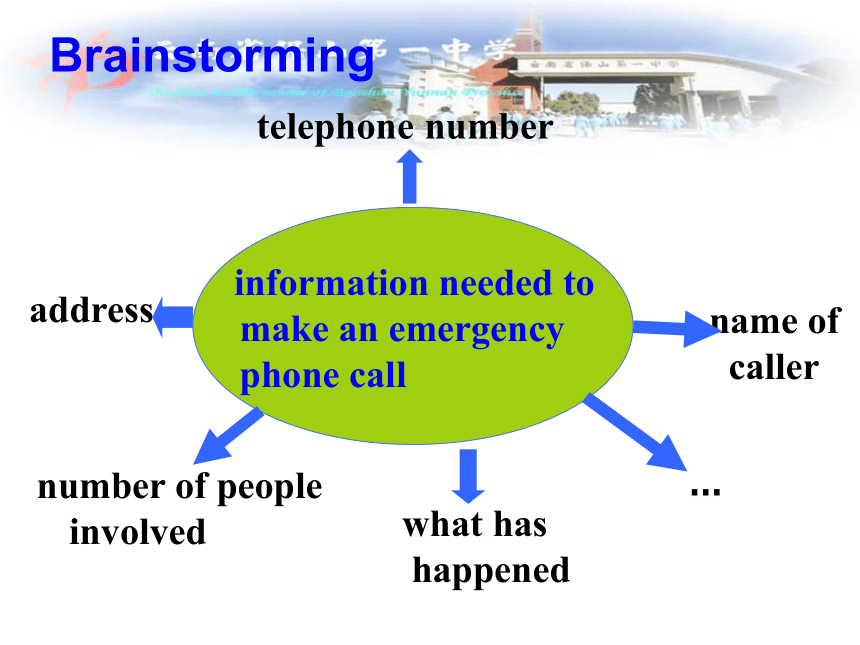
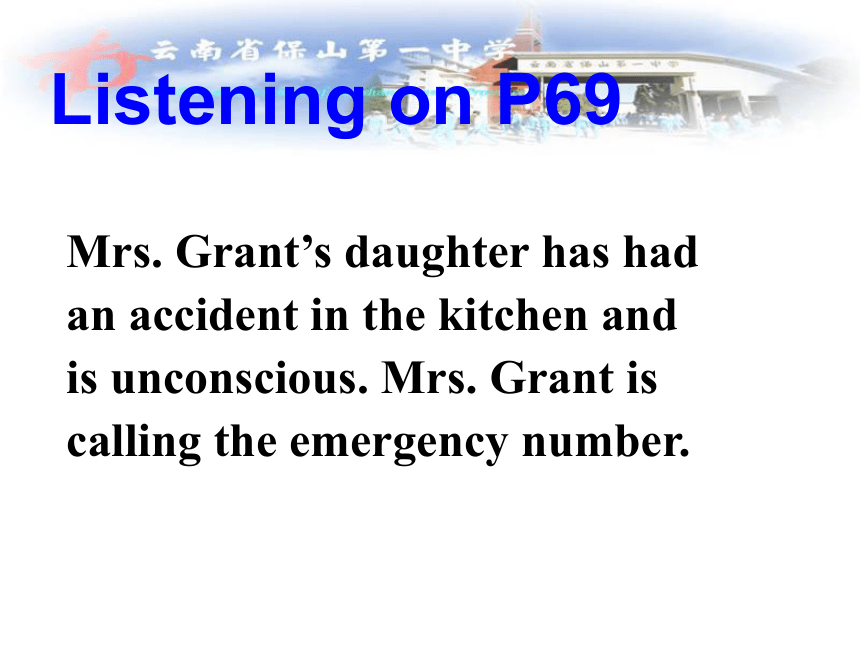

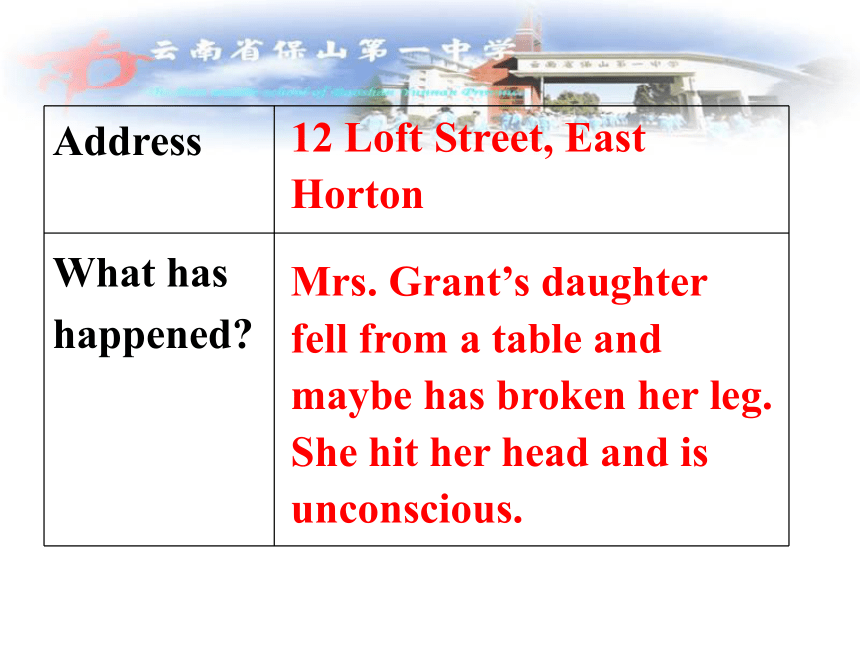
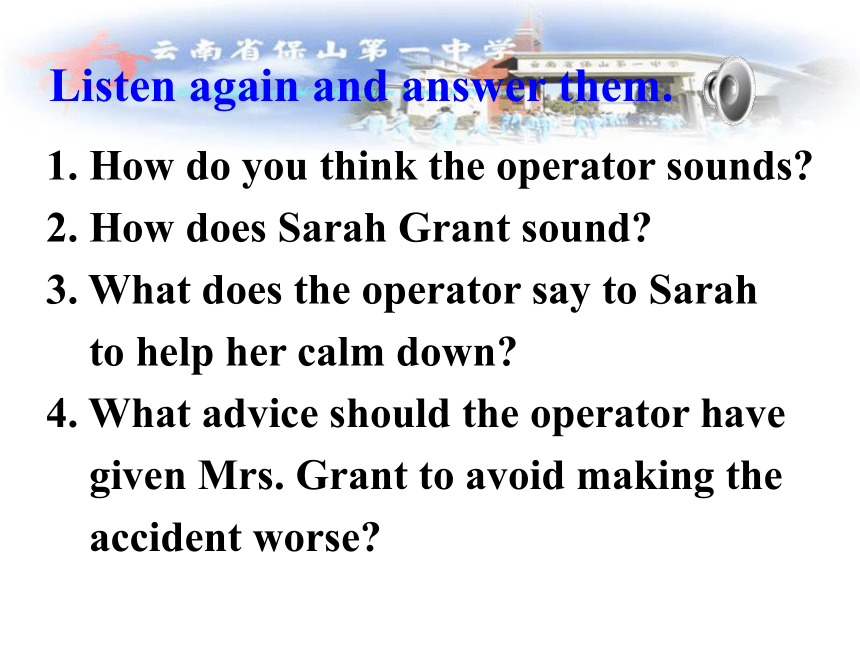
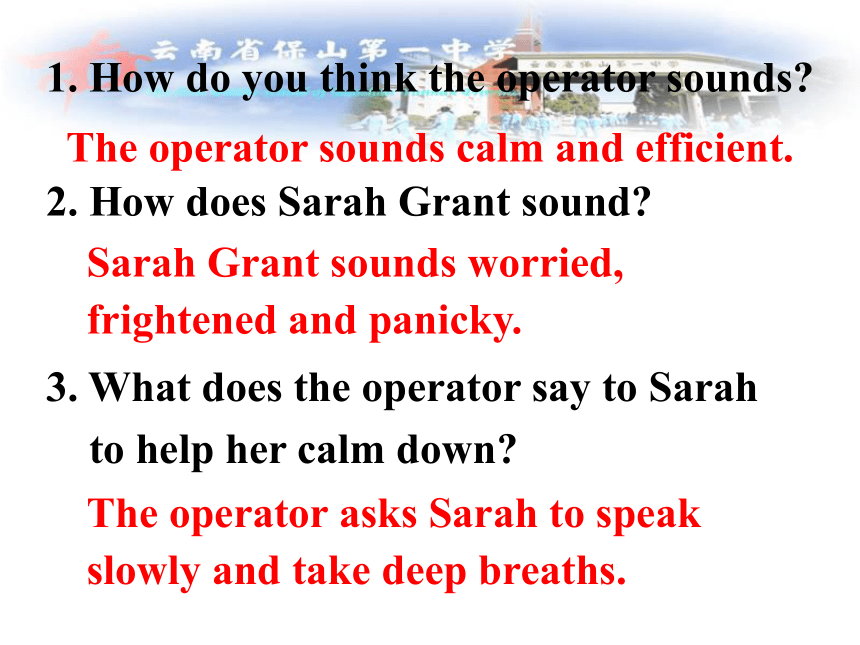

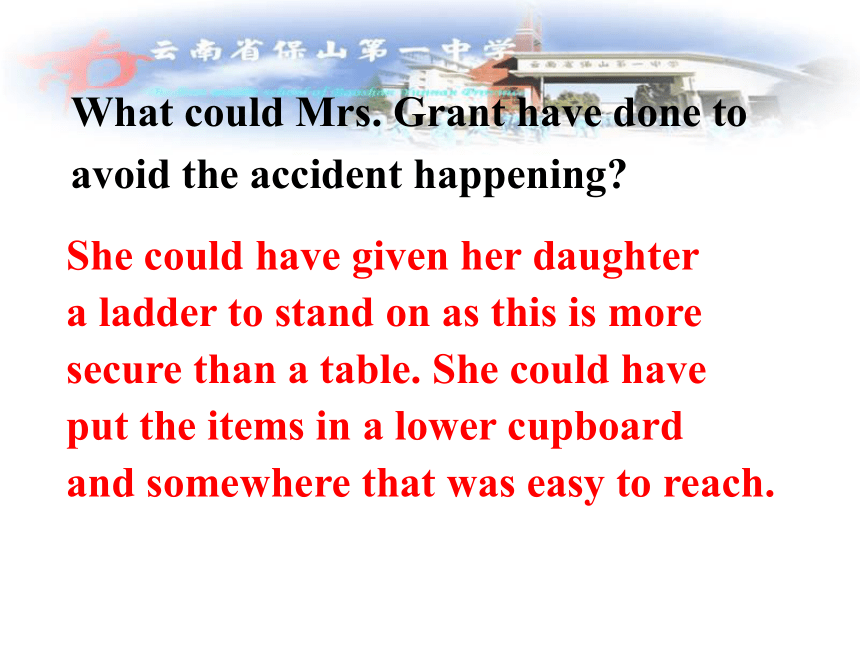
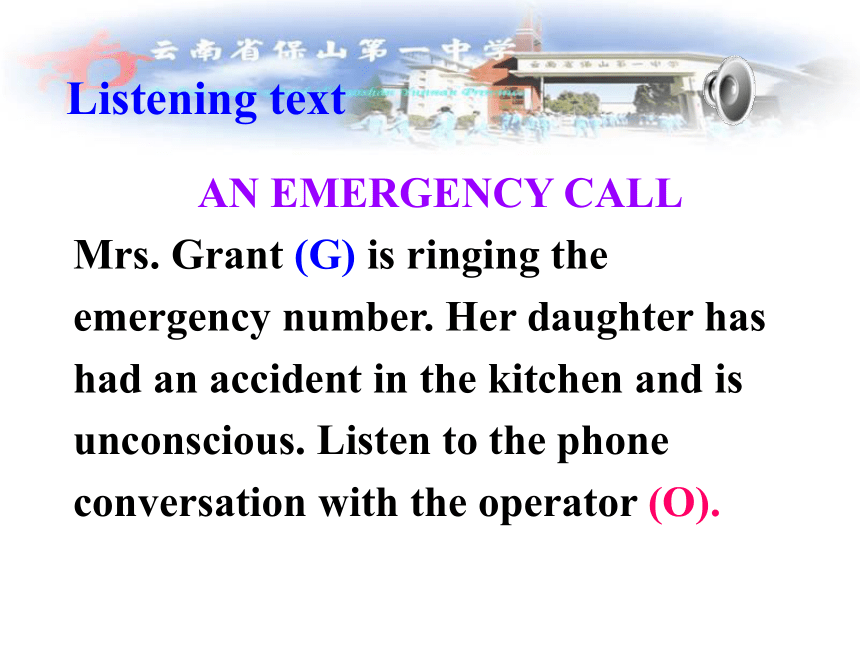
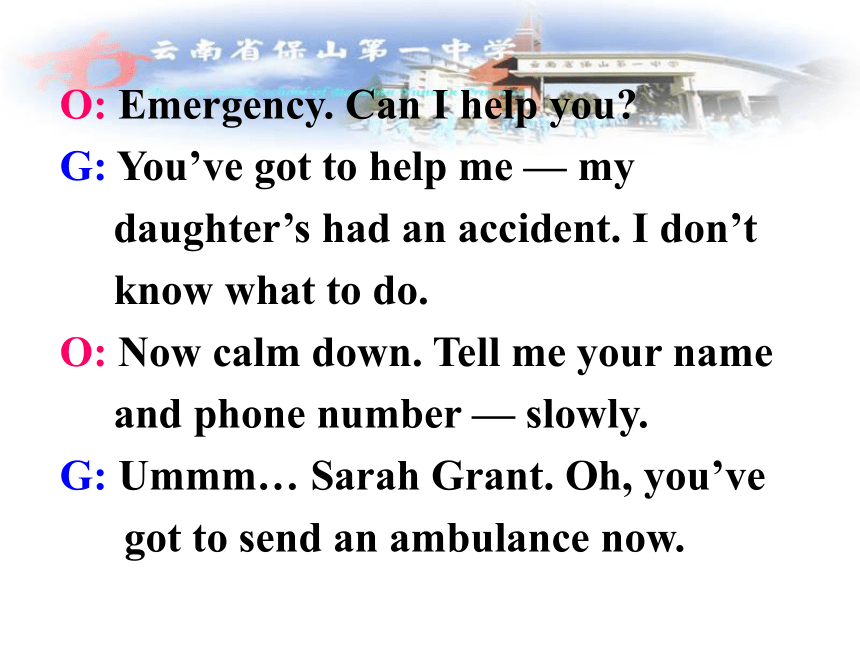
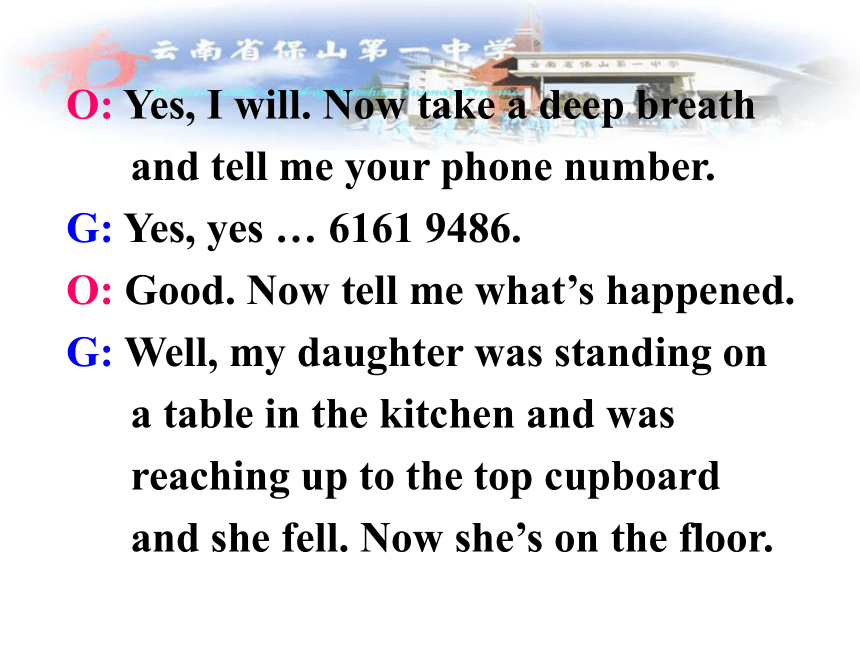
文档简介
课件53张PPT。Unit 5
First aid
Workbook Brainstormingname of
callertelephone numberaddresswhat has happenednumber of people involved…Listening on P69Mrs. Grant’s daughter has had an accident in the kitchen and is unconscious. Mrs. Grant is calling the emergency number.6161 9486Listen to the conversation and complete the table.One (Mrs. Grant’s daughter)Mrs. Grant’s daughter fell from a table and maybe has broken her leg. She hit her head and is unconscious.12 Loft Street, East Horton How do you think the operator sounds?
How does Sarah Grant sound?
3. What does the operator say to Sarah
to help her calm down?
4. What advice should the operator have
given Mrs. Grant to avoid making the
accident worse? Listen again and answer them. How do you think the operator sounds?
How does Sarah Grant sound?
3. What does the operator say to Sarah
to help her calm down?The operator asks Sarah to speak slowly and take deep breaths.The operator sounds calm and efficient.Sarah Grant sounds worried, frightened and panicky.4. What advice should the operator have
given Mrs. Grant to avoid making the
accident worse? The operator could have advised
Sarah Grant not to move her daughter
and to keep her warm by putting a
blanket over her.What could Mrs. Grant have done to
avoid the accident happening? She could have given her daughter
a ladder to stand on as this is more
secure than a table. She could have
put the items in a lower cupboard
and somewhere that was easy to reach.AN EMERGENCY CALL
Mrs. Grant (G) is ringing the emergency number. Her daughter has had an accident in the kitchen and is unconscious. Listen to the phone conversation with the operator (O).Listening textO: Emergency. Can I help you?
G: You’ve got to help me — my
daughter’s had an accident. I don’t
know what to do.
O: Now calm down. Tell me your name
and phone number — slowly.
G: Ummm… Sarah Grant. Oh, you’ve
got to send an ambulance now.O: Yes, I will. Now take a deep breath
and tell me your phone number.
G: Yes, yes … 6161 9486.
O: Good. Now tell me what’s happened.
G: Well, my daughter was standing on
a table in the kitchen and was
reaching up to the top cupboard
and she fell. Now she’s on the floor. Her leg looks strange — maybe it’s
broken. And she hit her head —
she’s unconscious. I’ve shouted at
her but she won’t wake up. Oh,
please hurry.
O: Yes, we will…
G: Oh thank you, thank you. Goodbye…
O: (interrupts) No, no, don’t hang up
— we need your address.G: Oh, sorry, I’m just so worried.
It’s 12 Loft Street, East Horton.
O: OK. 12 Loft Street, East Horton?
G: Yes, yes! Please be quick.
O: Right. The ambulance is on its way.
G: Thanks so much. Goodbye.
O: Goodbye.Reading taskWhat things at home can be dangerous?electrical equipmentelectric wirespoisonsladderskniveshot waterwindowsDiscussionHow to prevent us from being injured
at home?Before you read the pamphlet about safety in the home, find out these words in the text. Guess what they mean and then check their meanings in your dictionary. kit slippery ladder stove
appliances unplug hair dryer
extinguishers curtains wires outletsHave any accidents ever happened in your house? What happened and why did it happen? How do you think the
accident could have
been prevented?In the table below, write
down the things your
family already does in
your house to make it safe
and the things that you
shouldn’t do in your house. Add any other things your family does to make your home safe. In groups, share your answers.We always let the floor dry after it is washed before we use the kitchen again.I shouldn’t stand on a chair to reach things. We shouldn’t leave matches anywhere. My mother keeps bottles of medicine on a high shelf out of the reach of children.I shouldn’t light candles in my room.
My father should never smoke in bed.I always unplug the hairdryer after I’ve used it.We shouldn’t take an electric heater into the bathroom.Fill in the blanks._________ the floor is not ________.Make sureslipperyAlways use a _______ to _____ high cupboards.ladderreachAlways ________ from your body when you use a knife.cut away_______ all appliances, especially irons, after use.UnplugKeep matches ______________ of children.out of the reachThe kitchenElectricityMake sure that electric wires are safe and that children can’t touch them.More adviceThings in mouthDon’t leave small things on the floor or table which a baby can put in its mouth.PoisonsDon’t pour poisons into other containers,
for example, empty bottles. Keep them on
a high shelf out of the reach of children.
What must you do if you are badly burnt?Cool the area of skin at once. Wash the area of skin under the cold tap for several minutes. Put a piece of dry clean cloth over the area of the burn.How do you deal with a simple cut?Wash the area of the cut, dry it and cover it with a piece of dry clean cloth.Write more adviceGas fires:If you are using one of these, check that a window is open.Water:Make sure that young children can not get close to pools, lakes and rivers by themselves.Ladders:Don’t use one on a wet floor. Get someone to hold the ladder for you.
Don’t reach sideways while standing on a ladder. Get down first and move the ladder.Listening taskBefore you listening to the conversation, look at the phrases below and make sure you understand them.check if unconscious
put into recovery position feel a pulse
tilt the head backwards
clear the airway rescue breathingLook at the pictures and then listen to Parts 1 and 2. Number the boxes below to show the correct order of the pictures. 75248613Listen to Part 1 again and write down an instruction for each of the first four pictures. Then do the same for Part 2 and the rest of the pictures. continue rescue breathingblowing into mouth and watch for breathingput into recovery
positioncheck if breathingput into recovery
positioncheck pulsecheck if consciousclear airwayRESCUE BREATHING
A first aid teacher is reviving a lesson on rescue breathing.
T = teacher L = Lucy
P = Peter E = Eileen
Listening text Part 1
T: Now class, what must we do before
rescue breathing?
L: We must check if the person is
unconscious.
T: How do we do that?
L: We shake them. If there’s no
movement we know he or she is
unconscious.T: Yes, that’s right, Lucy. Anything else?
P: We can also ask simple questions like
“What’s your name?” or “Open your
eyes please!”
T: Exactly right, Peter. If the person
doesn’t move or answer then they’re
unconscious. Now how do we put the
person in a recovery position? E: I know this. First, you put one arm
straight out on the ground and bend
the other arm across the chest.
Second, you roll the person over onto
their side. Third, bend the near leg up.
T: Excellent, Eileen. What do you do to
the head.
E: You tilt the head backwards and turn
the face downwards a bit.T: Why?
E: To let any liquid run out of the mouth
and allow the tongue to fall forward.
T: Good, Eileen.
T: Now what’s next, Peter?
P: We must clear the airway from the
mouth to the lungs. We can use our
fingers inside the mouth.T: Why?
P: So we can check for breathing by
seeing if the chest is rising and falling.
Part 2
T: And …
P: And we put our cheek close to the
face to feel if there’s any air coming
from the nose or mouth.T: Well done, Peter. But what if the
person isn’t breathing?
L: You must start rescue breathing.
T: That’s right, Lucy. What should we
do?
L: Roll the person onto their back. Tilt
the head back. Squeeze the nose to
stop air coming out. Place your mouth over the person’s mouth. Blow into
the mouth for up to two seconds.
Watch the chest rise and fall. Take
another breath and blow into her
mouth again.
T: How long should you do this?
L: About 15 breaths a minute. After
about a minute check the pulse and
breathing again. Continue this process until the person breathes or
medical help arrives.
T: What should you do if breathing
begins?
L: Put the person in the recovery
position. If there’s no breathing then
continue breathing for them.
T: Well done, all of you. You remember
very well. Write a letter to your principal politely asking whether he or she could organize first aid courses. Dear _______,
Our class has been
studying a unit on first aid.
___________________________
_________________________
_________________________
______________. It has been very useful because we have learnt about what to do to help someone who has had an accidentWriting taskEven though the unit has been very interesting and useful, ___________________
__________________________________________________________________________________________________________________________________________________.Say why you would like a first aid course. we would like to be able to do a first aid course. A first aid course would give us information about many more situations. It would also give
us the chance to practise first aid treatments.We would like to request that____________________
_____________. We think that a first aid course at the school__________________
__________________________________________________________________________________________________________ .
Yours sincerely,Say what you want the principal to do.Say again why a first aid course would be a good thing to do.Sign your names the school organizes a first aid course is a necessary part of our education and will make us more useful members of our society. Perhaps we will even save someone’s life one day
Write a dialogue according
to the talking Ex. on P69. HomeworkThank You!
First aid
Workbook Brainstormingname of
callertelephone numberaddresswhat has happenednumber of people involved…Listening on P69Mrs. Grant’s daughter has had an accident in the kitchen and is unconscious. Mrs. Grant is calling the emergency number.6161 9486Listen to the conversation and complete the table.One (Mrs. Grant’s daughter)Mrs. Grant’s daughter fell from a table and maybe has broken her leg. She hit her head and is unconscious.12 Loft Street, East Horton How do you think the operator sounds?
How does Sarah Grant sound?
3. What does the operator say to Sarah
to help her calm down?
4. What advice should the operator have
given Mrs. Grant to avoid making the
accident worse? Listen again and answer them. How do you think the operator sounds?
How does Sarah Grant sound?
3. What does the operator say to Sarah
to help her calm down?The operator asks Sarah to speak slowly and take deep breaths.The operator sounds calm and efficient.Sarah Grant sounds worried, frightened and panicky.4. What advice should the operator have
given Mrs. Grant to avoid making the
accident worse? The operator could have advised
Sarah Grant not to move her daughter
and to keep her warm by putting a
blanket over her.What could Mrs. Grant have done to
avoid the accident happening? She could have given her daughter
a ladder to stand on as this is more
secure than a table. She could have
put the items in a lower cupboard
and somewhere that was easy to reach.AN EMERGENCY CALL
Mrs. Grant (G) is ringing the emergency number. Her daughter has had an accident in the kitchen and is unconscious. Listen to the phone conversation with the operator (O).Listening textO: Emergency. Can I help you?
G: You’ve got to help me — my
daughter’s had an accident. I don’t
know what to do.
O: Now calm down. Tell me your name
and phone number — slowly.
G: Ummm… Sarah Grant. Oh, you’ve
got to send an ambulance now.O: Yes, I will. Now take a deep breath
and tell me your phone number.
G: Yes, yes … 6161 9486.
O: Good. Now tell me what’s happened.
G: Well, my daughter was standing on
a table in the kitchen and was
reaching up to the top cupboard
and she fell. Now she’s on the floor. Her leg looks strange — maybe it’s
broken. And she hit her head —
she’s unconscious. I’ve shouted at
her but she won’t wake up. Oh,
please hurry.
O: Yes, we will…
G: Oh thank you, thank you. Goodbye…
O: (interrupts) No, no, don’t hang up
— we need your address.G: Oh, sorry, I’m just so worried.
It’s 12 Loft Street, East Horton.
O: OK. 12 Loft Street, East Horton?
G: Yes, yes! Please be quick.
O: Right. The ambulance is on its way.
G: Thanks so much. Goodbye.
O: Goodbye.Reading taskWhat things at home can be dangerous?electrical equipmentelectric wirespoisonsladderskniveshot waterwindowsDiscussionHow to prevent us from being injured
at home?Before you read the pamphlet about safety in the home, find out these words in the text. Guess what they mean and then check their meanings in your dictionary. kit slippery ladder stove
appliances unplug hair dryer
extinguishers curtains wires outletsHave any accidents ever happened in your house? What happened and why did it happen? How do you think the
accident could have
been prevented?In the table below, write
down the things your
family already does in
your house to make it safe
and the things that you
shouldn’t do in your house. Add any other things your family does to make your home safe. In groups, share your answers.We always let the floor dry after it is washed before we use the kitchen again.I shouldn’t stand on a chair to reach things. We shouldn’t leave matches anywhere. My mother keeps bottles of medicine on a high shelf out of the reach of children.I shouldn’t light candles in my room.
My father should never smoke in bed.I always unplug the hairdryer after I’ve used it.We shouldn’t take an electric heater into the bathroom.Fill in the blanks._________ the floor is not ________.Make sureslipperyAlways use a _______ to _____ high cupboards.ladderreachAlways ________ from your body when you use a knife.cut away_______ all appliances, especially irons, after use.UnplugKeep matches ______________ of children.out of the reachThe kitchenElectricityMake sure that electric wires are safe and that children can’t touch them.More adviceThings in mouthDon’t leave small things on the floor or table which a baby can put in its mouth.PoisonsDon’t pour poisons into other containers,
for example, empty bottles. Keep them on
a high shelf out of the reach of children.
What must you do if you are badly burnt?Cool the area of skin at once. Wash the area of skin under the cold tap for several minutes. Put a piece of dry clean cloth over the area of the burn.How do you deal with a simple cut?Wash the area of the cut, dry it and cover it with a piece of dry clean cloth.Write more adviceGas fires:If you are using one of these, check that a window is open.Water:Make sure that young children can not get close to pools, lakes and rivers by themselves.Ladders:Don’t use one on a wet floor. Get someone to hold the ladder for you.
Don’t reach sideways while standing on a ladder. Get down first and move the ladder.Listening taskBefore you listening to the conversation, look at the phrases below and make sure you understand them.check if unconscious
put into recovery position feel a pulse
tilt the head backwards
clear the airway rescue breathingLook at the pictures and then listen to Parts 1 and 2. Number the boxes below to show the correct order of the pictures. 75248613Listen to Part 1 again and write down an instruction for each of the first four pictures. Then do the same for Part 2 and the rest of the pictures. continue rescue breathingblowing into mouth and watch for breathingput into recovery
positioncheck if breathingput into recovery
positioncheck pulsecheck if consciousclear airwayRESCUE BREATHING
A first aid teacher is reviving a lesson on rescue breathing.
T = teacher L = Lucy
P = Peter E = Eileen
Listening text Part 1
T: Now class, what must we do before
rescue breathing?
L: We must check if the person is
unconscious.
T: How do we do that?
L: We shake them. If there’s no
movement we know he or she is
unconscious.T: Yes, that’s right, Lucy. Anything else?
P: We can also ask simple questions like
“What’s your name?” or “Open your
eyes please!”
T: Exactly right, Peter. If the person
doesn’t move or answer then they’re
unconscious. Now how do we put the
person in a recovery position? E: I know this. First, you put one arm
straight out on the ground and bend
the other arm across the chest.
Second, you roll the person over onto
their side. Third, bend the near leg up.
T: Excellent, Eileen. What do you do to
the head.
E: You tilt the head backwards and turn
the face downwards a bit.T: Why?
E: To let any liquid run out of the mouth
and allow the tongue to fall forward.
T: Good, Eileen.
T: Now what’s next, Peter?
P: We must clear the airway from the
mouth to the lungs. We can use our
fingers inside the mouth.T: Why?
P: So we can check for breathing by
seeing if the chest is rising and falling.
Part 2
T: And …
P: And we put our cheek close to the
face to feel if there’s any air coming
from the nose or mouth.T: Well done, Peter. But what if the
person isn’t breathing?
L: You must start rescue breathing.
T: That’s right, Lucy. What should we
do?
L: Roll the person onto their back. Tilt
the head back. Squeeze the nose to
stop air coming out. Place your mouth over the person’s mouth. Blow into
the mouth for up to two seconds.
Watch the chest rise and fall. Take
another breath and blow into her
mouth again.
T: How long should you do this?
L: About 15 breaths a minute. After
about a minute check the pulse and
breathing again. Continue this process until the person breathes or
medical help arrives.
T: What should you do if breathing
begins?
L: Put the person in the recovery
position. If there’s no breathing then
continue breathing for them.
T: Well done, all of you. You remember
very well. Write a letter to your principal politely asking whether he or she could organize first aid courses. Dear _______,
Our class has been
studying a unit on first aid.
___________________________
_________________________
_________________________
______________. It has been very useful because we have learnt about what to do to help someone who has had an accidentWriting taskEven though the unit has been very interesting and useful, ___________________
__________________________________________________________________________________________________________________________________________________.Say why you would like a first aid course. we would like to be able to do a first aid course. A first aid course would give us information about many more situations. It would also give
us the chance to practise first aid treatments.We would like to request that____________________
_____________. We think that a first aid course at the school__________________
__________________________________________________________________________________________________________ .
Yours sincerely,Say what you want the principal to do.Say again why a first aid course would be a good thing to do.Sign your names the school organizes a first aid course is a necessary part of our education and will make us more useful members of our society. Perhaps we will even save someone’s life one day
Write a dialogue according
to the talking Ex. on P69. HomeworkThank You!
